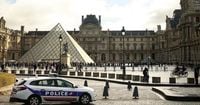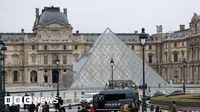In a case that has gripped France and the international art world, police have arrested seven suspects in connection with the audacious jewel heist at Paris’ Louvre Museum, a crime that saw eight pieces of priceless French crown jewels vanish in a matter of minutes. The incident, which unfolded on the morning of October 19, 2025, has not only raised serious questions about museum security but also sparked a nationwide reckoning over how cultural treasures are protected in one of the world’s most visited museums.
According to BBC and ABC News, the latest development came on October 29, when five individuals were apprehended during coordinated raids in the Paris region, including the suburb of Seine-Saint-Denis. Paris Prosecutor Laure Beccuau confirmed the arrests, stating that one of the suspects had been a major target for investigators after his DNA was found at the crime scene. “We had him in our sights,” Beccuau told RTL radio, underscoring the methodical nature of the investigation. The arrests bring the total number of people detained in relation to the heist to seven.
The two earlier suspects, both men in their 30s with criminal records, were detained late last week in Aubervilliers, a northern suburb of Paris. One, a 34-year-old Algerian national who has lived in France since 2010, was arrested at Charles de Gaulle Airport as he attempted to board a flight to Algeria with no return ticket. The other, aged 39, was arrested at his home. Both men’s DNA was matched to evidence recovered from the scene—one on a scooter used in the getaway, the other on a glass display case and items left behind. These two have “partially recognized” their involvement in the theft, according to Beccuau, and have been handed preliminary charges of criminal conspiracy and theft committed by an organized gang. They remain in custody pending further investigation.
Surveillance footage and evidence pieced together by investigators reveal a meticulously planned operation. At 9:30 a.m., just after the museum opened to visitors, four thieves arrived in a truck equipped with a mechanical lift. Using the lift, they accessed an upstairs window leading to the Apollo Gallery, home to some of France’s most storied treasures. Armed with power tools, the group forced their way in, cracked open display cases, and made off with eight pieces of jewelry—19th-century tiaras, necklaces, earrings, and a brooch once belonging to the wives of Emperors Napoleon I and Napoleon III. The entire operation took a mere four minutes, and not a single person was threatened during the raid.
After grabbing the jewels, the thieves fled on two scooters along the Seine River before switching to cars and heading east. The speed and precision of the crime have left many stunned. “They knew exactly where they were going. It looks like something very organized and very professional,” French Culture Minister Rachida Dati told ABC News last week. The loot, valued at 88 million euros (about $102 million), remains missing, and experts fear the pieces may already have been broken down or recut to erase their provenance.
Despite initial speculation, authorities say there is no evidence at this stage to suggest that museum staff were involved. “Nothing suggests that the robbers had any accomplices within the museum’s staff,” Beccuau stated at a press conference. However, the investigation continues, and phones and objects seized during the raids are being analyzed for encrypted messages that could shed light on the broader network behind the theft.
The scale and brazenness of the heist have exposed significant vulnerabilities in the Louvre’s security infrastructure. Paris Police Chief Patrice Faure, addressing Senate lawmakers, acknowledged that aging systems and slow-moving upgrades left the museum exposed. Parts of the video surveillance network remain analog, producing grainy images and making real-time monitoring difficult. To make matters worse, the Louvre’s authorization to operate its security cameras had expired in July and had not been renewed, a bureaucratic lapse Faure described as emblematic of deeper issues. “A technological step has not been taken,” he admitted, pointing out that a long-promised $93 million overhaul of the surveillance system won’t be completed before 2029 or 2030.
Faure also revealed that the first alert to police did not come from the museum’s alarms or security staff but from a cyclist outside who saw helmeted men with a basket lift and dialed the emergency line. While officers arrived quickly after the theft was reported, the delay in detection and communication proved costly. Faure has urged lawmakers to authorize new tools, such as AI-based anomaly detection and object tracking, to flag suspicious movements and track suspects across city cameras in real time—though he stressed this would not involve facial recognition.
The Louvre, already under pressure from staff strikes earlier in the year over crowding and chronic understaffing, now finds itself at the center of a national debate about the protection of cultural heritage. In June, security agents joined a spontaneous strike, citing “untenable” working conditions and mass tourism creating blind spots in security. The vulnerabilities highlighted by the heist have forced museum officials to act swiftly. Some of the Louvre’s most precious jewels have been transferred to the Bank of France for safekeeping, stored 26 meters below ground in the Bank’s most secure vault.
The museum’s director, facing intense scrutiny, acknowledged the gravity of the security failures and offered her resignation, which Culture Minister Dati refused. “Today we are experiencing a terrible failure at the Louvre, which I take my share of responsibility in,” the director told the French Senate. Dati, for her part, insisted that while alarms did function, “security gaps did exist.”
As the investigation continues, authorities believe the gang may be larger than the four men who physically committed the theft. Beccuau has indicated that some of the newly arrested suspects may eventually provide crucial information about how the incident unfolded. For now, the dazzling jewels remain missing, their fate uncertain, and the Louvre—like much of France—remains on edge, determined to prevent such a loss from ever happening again.
The story of the Louvre heist is far from over. With seven suspects in custody, a sprawling investigation underway, and the world watching, France’s most famous museum is racing to restore both its treasures and its reputation.


